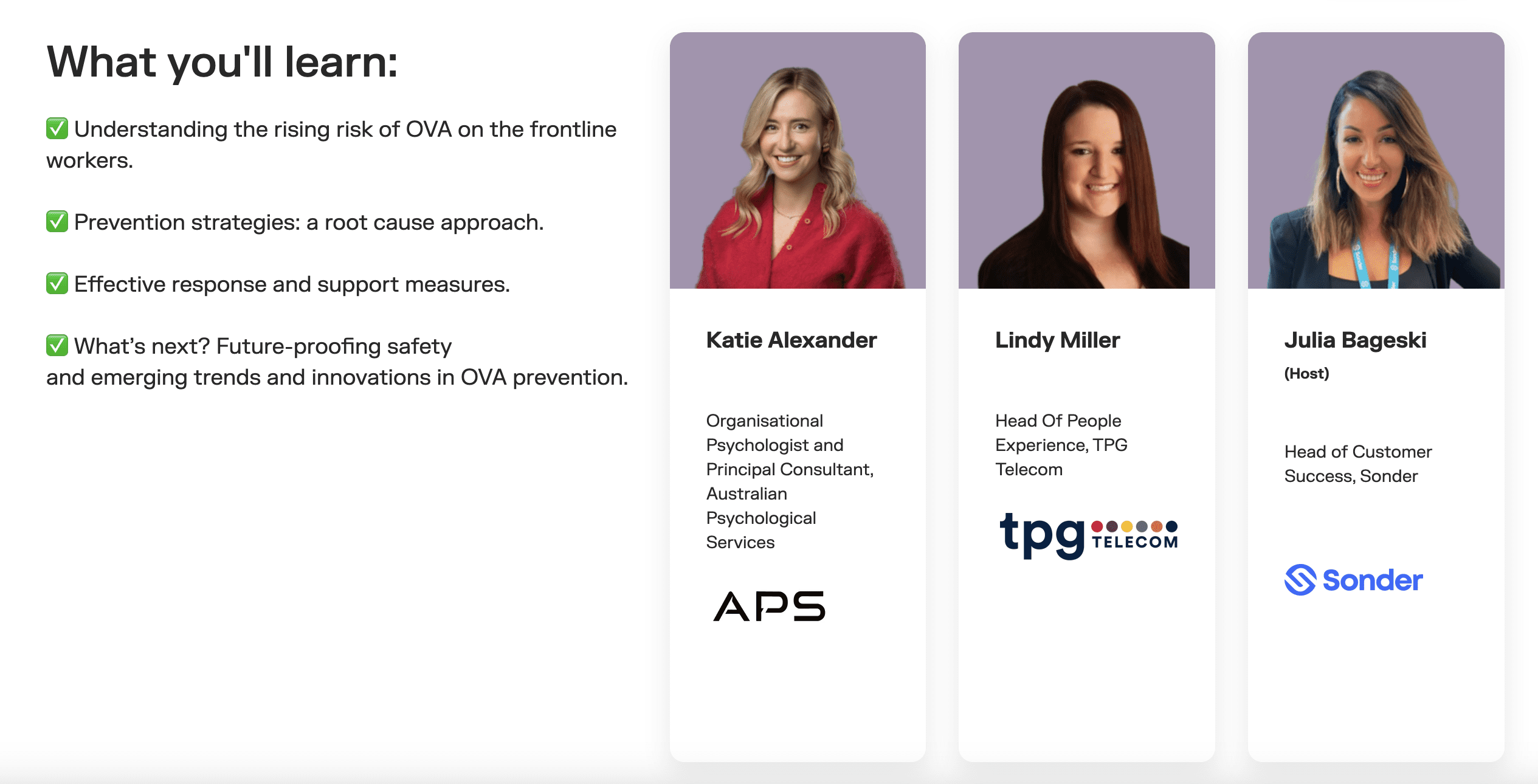A sobering 75% of employees in customer-facing roles report experiencing customer aggression. But this isn’t just a statistic: it’s the daily reality for many hardworking Australians.
If you’re leading a team of frontline workers, it’s never been more important to put strategies in place to safeguard against occupational violence and aggression (OVA).
Missed our recent webinar on tackling occupational violence and aggression on the frontline? Hear from our panelists Katie Alexander (Organisational Psychologist and Principal Consultant at APS), Lindy Miller (Head of People Experience at TPG) with Host, Julia Bageski (Head of Customer Success at Sonder) as they share their top strategies for preventing occupational violence.

What are the risks of occupational violence and aggression?
Occupational violence and aggression (OVA) is an umbrella term for a range of behaviours that put your frontline workers at risk. OVA covers everything from lower-level behaviours (including verbal abuse, hostility and intimation) all the way through to more severe behaviours (such as physical violence and sexual harassment).
“At the moment, we’re seeing a high incidence of lower level behaviours, such as verbal aggression, anger, hostility, and intimidation. However, these behaviours are often repeated and are something that our workers experience on a daily, weekly, and monthly basis. And so that potential for harm is really, really high.”

Katie Alexander
Organisational Psychologist and Principal Consultant at APS
Unfortunately, customer violence and aggression are on the rise. Since 2018, there has been a 56% increase in serious workers’ compensation claims related to occupational violence and aggression.
Our research reveals that almost half of frontline workforces face customer aggression on a weekly basis, with 25% experiencing OVA every week or more. Concerningly, 29% of workers who experienced customer aggression didn’t receive any support from their employer.
But it’s not just acts of physical aggression that people leaders need to be concerned about. Many frontline workers are regularly encountering disrespectful behaviour from customers that can put their health, wellbeing and safety at risk.
“At TPG, we don’t want to limit OVA to just violence and aggression. Yes, that’s absolutely occurring, but we’ve also seen a rise in just general disrespectful behaviours, including, unfortunately, sexual harassment as well as as well as racial vilification.”

Lindy Miller
Head of People Experience at TPG
Developing effective response plans for OVA
Companies with frontline workers need to have an effective response plan in place to combat the employee safety risks of OVA.
So, what does an effective response plan look like? Our panelists pointed to several key factors that have enabled their organisations to build effective response strategies, including:
- Conducting a root cause analysis after every incident: Reviewing the triggers that sparked each incident allows organisations to spot trends and assess the root causes behind OVA incidents. From there, leaders can roll out targeted interventions that proactively prevent similar incidents from occurring in the future.
- Empowering leaders to be the ‘first line of defense’: Leaders need to be equipped with psychological first aid training and empowered to recognise and respond when they spot a frontline worker in distress, ensuring frontline workers aren’t left to navigate and process incidents alone.
“We need to make sure there’s that leadership commitment to zero tolerance. It’s a real challenge that we are seeing. But leaders have an important role to play in ensuring customer-facing employees are supported to disengage from situations and not put themselves in harm’s way for the sake of it.”

Katie Alexander
Organisational Psychologist and Principal Consultant at APS
- Adopting a people-centred approach: Every team member will respond differently to an OVA incident, meaning companies should offer a wide range of support options (not mandatory interventions). This allows people to be at the centre of their recovery, ensuring that care is personalised and never one-size-fits-all.
- Thinking beyond the immediate response: In many cases, employees may have a delayed response to an incident. The best response plans look beyond the immediate 48 hours after an incident, giving leaders the tools and training to step up an employee’s level of care and connect them with professional support through tools like Sonder.
“We always take a whole of employee life cycle approach to how we look at these incidents or situations and risks. First and foremost, do a root cause analysis, really look at the data, understand common triggers, and then look upstream to target interventions to prevent incidents from even occurring.”

Katie Alexander
Organisational Psychologist and Principal Consultant at APS
Practical steps for people leaders to prevent OVA incidents
Preventing incidents before they occur is an even more crucial piece of the puzzle. If you’re ready to manage and mitigate safety risks for frontline employees, here are five practical places to start:
- Understand how to conduct a thorough risk assessment: Using a root cause analysis or risk assessment allows your team to understand the common themes and causes of incidents, giving you the insights you need to put preventative measures in place.
- Stay on top of incident reporting data: Data management is key to ensure you take an informed, data-driven approach to your risk mitigation strategy. Speak directly with impacted workers and leverage analytics from platforms like Sonder to gain real-time feedback on where problems are occurring and why.
“The richer source of data has come from when we’ve run focus groups with our frontline.”

Lindy Miller
Head of People Experience at TPG
- Double down on training programs: Employees and leaders need to feel supported with robust de-escalation processes and frameworks for handling incidents. Plus, ensure team members are up-to-speed on the protocols and procedures in place when navigating high-risk situations, such as being a lone worker on shift late at night.
- Create open feedback loops with frontline employees: Listening to frontline workers is key to building policies and processes that will solve the real-world challenges they’re facing. Ensure you’re continually gaining input from frontline team members and creating strategies that are informed by lived experience.
- Build robust debriefing processes: By running effective, timely debriefing sessions, leaders can gain first-hand insights into the triggers of frontline incidents and pinpoint opportunities to prevent these issues from occurring in the first place. Plus, it ensures leaders can spot when a team member might be struggling after an incident, allowing them to connect frontline workers with the right tailored resources and support.
Plus, there are new trends emerging in frontline worker safety that are showing the importance of carefully evaluating company processes to ensure these don’t inadvertently cause harm to team members.
“A lot of the innovations we’re seeing are simply coming from understanding how an organisation’s processes and policies perhaps actually escalate situations without us intending that to be the case. We need to take a psychosocial lens to these changes to understand how we might be inadvertently increasing risk.”

Katie Alexander
Organisational Psychologist and Principal Consultant at APS
Want to learn more about tackling occupational violence and aggression on the frontline? Watch this webinar on-demand.
About Sonder
Sonder is a technology company that helps organisations improve the wellbeing of their people so they perform at their best. Our mobile app provides immediate, 24/7 support from a team of safety, medical, and mental health professionals – plus onsite help for time-sensitive scenarios. Accredited by the Australian Council on Healthcare Standards (ACHS), our platform gives leaders the insights they need to act on tomorrow’s wellbeing challenges today.



